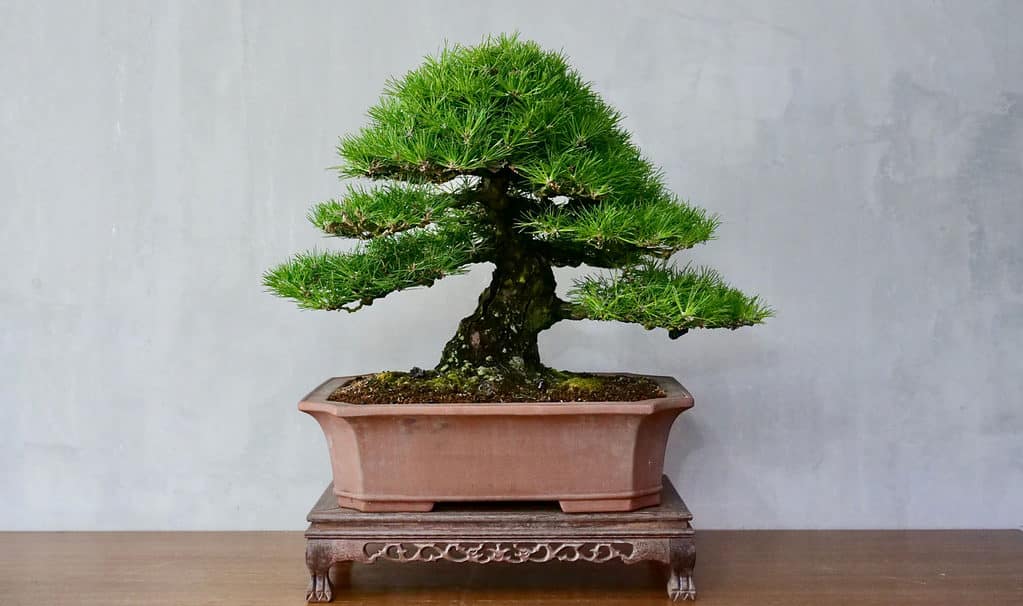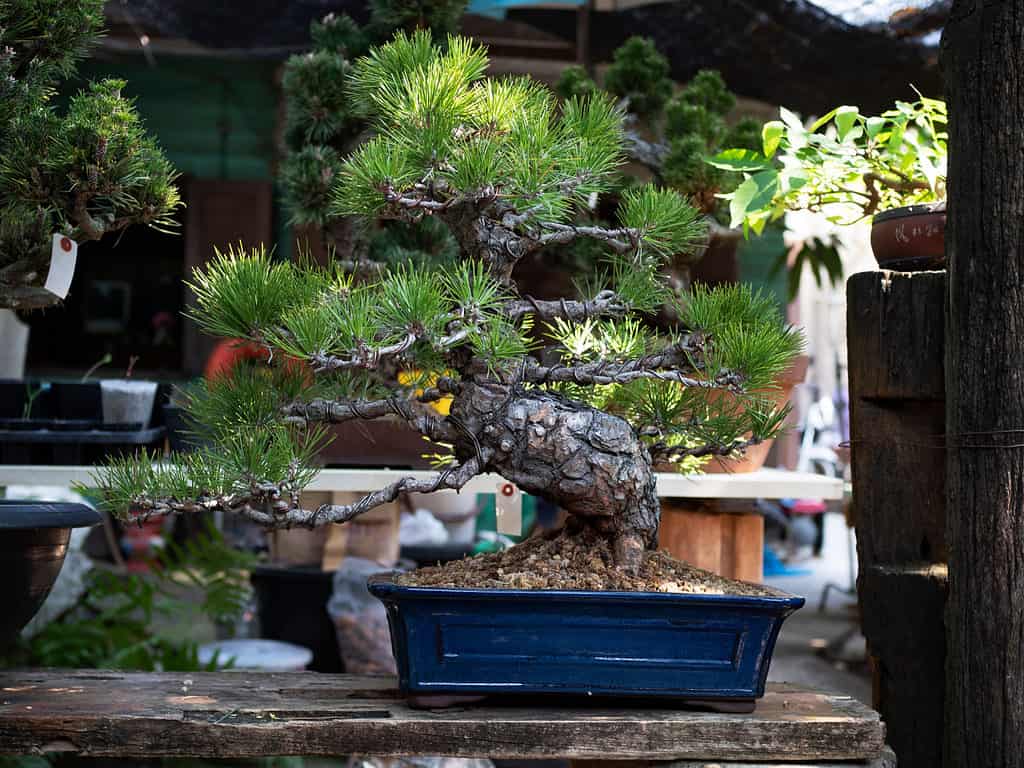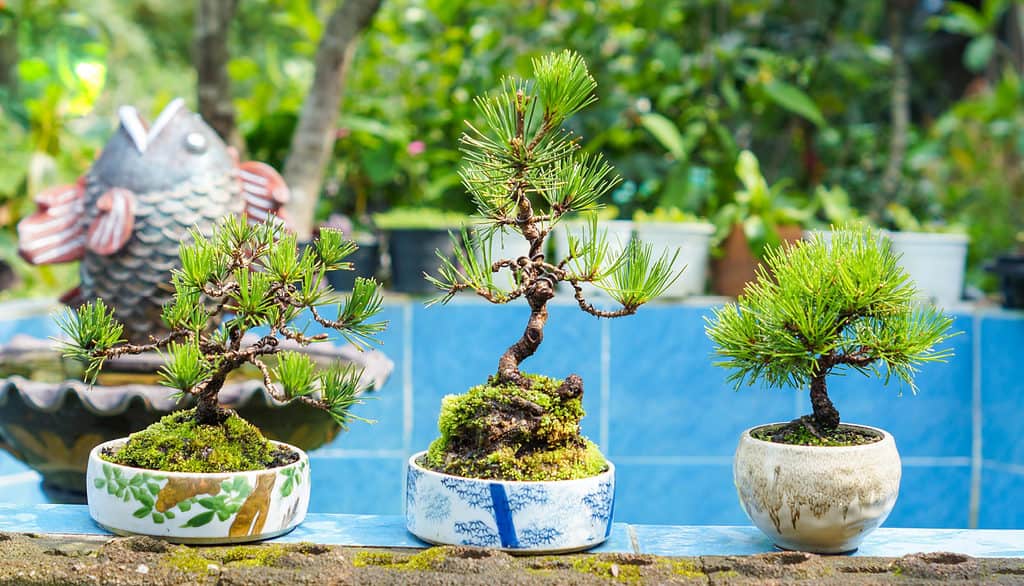Japanese black pine trees are an important part of Japan’s history and cultural identity, historically planted in the gardens of temples. They grow along the coastline of Japan and are easily identified by the dark-colored bark on their trunks. For these reasons and many more, Japanese black pine trees are especially suited to Bonsai tree art. Read on to discover everything you need to know about growing and styling a Japanese black pine Bonsai tree!

Because Japanese black pine trees originate on the coast, they are often used to cool, moist environments.
©Lilly Kauffman/Shutterstock.com
| Japanese Black Pine Bonsai Tree Information | |
|---|---|
| Botanical Name | Pinus thunbergii |
| Common Types | Majestic Beauty, Oculus Draconis, Shirone Jamone, Thunderhead, Pygmaea |
| Sunlight | Full sun in cooler regions, partial shade in hot regions |
| Soil | Moist, well-draining, generally on the acidic side. |
| Water | Less water than other Bonsai trees; some variations are even drought tolerant |
| For Beginners? | Yes! Japanese black pine trees are hardy and easy to take care of. Pruning them can be easy, too. |
| Indoors or Outdoors? | Outdoors |
| Pairs Well With… | Moss, rocks, and other natural ornamentation |
Common Types of Japanese Black Pine Bonsai Trees

On the coastline of Japan, where these trees can be found in the wild, the wet weather and heavy winds strip these trees of their needles in the early summer.
©Thanun Patiparnthada/Shutterstock.com
Japanese black pine trees are known for their black or gray colored bark. They are considered to be “two-flush” pine trees, which means that, essentially, their needles come in twice a year. On the coastline of Japan, where these trees can be found in the wild, the wet weather and heavy winds strip these trees of their needles in the early summer. By fall, they have grown back. When planted outside of these conditions, Japanese black pine trees do not lose their needles. They can be pruned off for Bonsai art, which does have some benefits, but we’ll talk more about that later!
Because Japanese black pine trees originate on the coast, they are often used to cool, moist environments. But they can thrive just about anywhere as long as it isn’t too hot!
Technically speaking, there are six types of Japanese black pine trees. The first is the pure Japanese black pine, and the other five are cultivars of this parent tree. Most of the time these cultivars have been bred to be smaller versions of their parent tree. While the pure Japanese black pine can be grown as a Bonsai tree, some of its smaller cultivars suit Bonsai tree art much better.
Majestic Beauty
When planted naturally, and found on the coast of Japan, these trees can reach heights of up to 50 or 60 feet. Majestic Beauty black pine trees are more compact than their parent tree. This makes them suited for Bonsai tree art.
Majestic Beauty black pine trees thrive best beneath full sun and in moist, well-draining soil that is acidic. They are frost and cold hardy trees that can also survive some drought.
Oculus Draconis
These dwarf trees can grow to be 6 to 8 feet tall when planted naturally. Their small stature makes them good for Bonsai tree art! The name “Oculus Draconis” translates to “Dragon’s Eye” in Latin. These trees were given that name because of the coloring of their needles. The bottom of the needles, where the pinecones sprout, is yellow. This coloration makes each bundle of needles look like eyes!
Oculus Draconis black pine trees thrive best beneath full sun in moist, well-draining soil.
Shirone Jamone
The name “Shirone Jamone”, translated from Japanese, means “cold white eyes of the snake”. They are given this name because of the coloring of their needles. On each needle of these trees are two yellow bands. Amidst the rest of the dark-green needle, these bands look a lot like snake eyes!
Shirone Jamone black pine trees thrive best beneath full sun in moist, well-draining soil.
Thunderhead
The Thunderhead variety of the Japanese black pine resembles shrubs more than they do trees. They are compact, the foliage packed closely together. This makes these trees suited to Bonsai tree art! The tip of each branch on these trees is a lovely silvery-white color, resembling a candle in the middle of vibrant, dark green needles.
Thunderhead black pine trees thrive best beneath full sun in moist, well-draining soil that is on the acidic side. They can grow in neutral soil, as well.
Pygmaea
The Pygmaea variety of the Japanese black pine is another compact cultivar. Their small stature makes them perfect for Bonsai tree art! These trees, which look more like shrubs than trees, are shaped irregularly when left to grow naturally. They are definitely wider than thicker! Pygmaea black pine trees are known for being especially hardy little trees, tolerant of drought, salt, and poor soil conditions.
Pygmaea black pine trees need full sun to grow their best when planted in moist, well-draining soil.
Caring for Your Japanese Black Pine Bonsai Tree

While not the easiest to shape, Japanese black pine trees are known for being hardy and low maintenance, ideal for beginners!
©TONG2519/Shutterstock.com
Thankfully, caring for a Japanese black pine Bonsai tree isn’t too difficult! These trees can be relatively low maintenance, which is good news for beginners and advanced Bonsai tree artists alike.
Here are some tips for taking care of your Japanese black pine Bonsai tree and helping it grow its best!
Sunlight
Across the board, all Japanese black pine Bonsai trees need full sun to thrive. They can still grow well in partial sun or shade, but their needles will grow longer which can hinder the pruning process.
Soil Type
Any Bonsai tree needs well-draining soil and the Japanese black pine Bonsai tree is no exception. Other soil conditions can range from cultivar to cultivar, but any specialty Bonsai tree soil mix should suit your Japanese black pine Bonsai tree well!
Water
Like most other Bonsai trees, take care to make sure the root ball of your Japanese black pine Bonsai tree does not dry out all the way. Some variations of the Japanese black pine are drought tolerant, like the Pygmaea cultivar. As a whole, pine Bonsai trees do not need or even like as much water as other Bonsai trees.
If you do choose to prune the first flush of needles from your Japanese black pine Bonsai tree, take care to keep it from heavy rains while the second flush is growing. Too much water and these second flush needles can grow very long.
Placement
For the most part, your Japanese black pine Bonsai tree can stay outdoors throughout the year! They do need special protections when it gets too hot or too cold. If you are growing a Japanese black pine Bonsai tree somewhere warm, it is a good idea to either keep it in partial shade in the summer or bring it inside. If you bring your tree indoors, make sure to place it where it can still find the sun!
Because they are used to cool environments, Japanese black pine trees are tolerant of the cold. But when planted and grown in Bonsai containers, they do weaken a bit. To protect your Japanese black pine tree from harsh winter conditions, you can keep it in a cold-frame greenhouse, a shed, or a garage. Basically, you can keep it in any place where it can still see the sun but won’t be harmed by frost or winds!
Pruning Your Japanese Black Pine Bonsai Tree

When you remove the candles from your Japanese black pine Bonsai tree in the summer, make sure to leave behind enough of a stub for needles to continue growing.
©Olena Antonenko/Shutterstock.com
For the most part, Japanese black pine trees take well to pruning and being shaped. This is because they are strong, hardy trees with thick trunks.
To mimic the second flush of needles that Japanese black pine trees experience in the wild, you can prune away the first flush of growth. You can start doing this in late spring or early summer. At that time, you’ll want to extract the candles from your Japanese black pine Bonsai tree. Every spring, every type of pine tree develops upright buds that sit at the end of each branch. These are called candles. When you remove them from your Japanese black pine Bonsai tree in the summer, make sure to leave behind enough of a stub for needles to continue growing. For best results, this stub should be about 1/4” long with a small number of needles surrounding it.
In the fall, when the second growth of needles has grown, you can cut any extra shoots from your tree.
Ideal Japanese Black Pine Bonsai Tree Styles

Some pine tree species are more flexible than others, which may make them easier to shape.
©qSPOoKYp/Shutterstock.com
One of the many benefits of growing a Japanese black pine Bonsai tree is the fact that they can be shaped in many different styles! They suit easier styles like Chokkan, as well as more dramatic styles like Han-kengai just as well!
Chokkan is known as the formal upright style and is probably one of the easiest Bonsai tree styles to achieve. Japanese black pine trees are great for this style because of their strong trunks and vivid, often dense, foliage. A similar, but more challenging, style is the Sokan style. It’s very similar to Chokkan, except that it involves splitting your Bonsai tree into two trunks. There is also the Moyogi style, the informal upright style. In this style, Bonsai trees are shaped into a shape that resembles the letter S.
Han-kengai is a challenging, but beautiful, style of Bonsai tree art. In this style, Bonsai trees are shaped and pruned to sweep downward once their trunks have grown a few inches upright. Japanese black pine trees are suited to this style because of their strong, thick trunks.
Propagating Your Japanese Black Pine Bonsai Tree

Growing a Japanese black pine tree can be achieved from seeds or by grafting, depending on which option you have access to!
©JIMKOJI/Shutterstock.com
Japanese black pine Bonsai trees can easily be propagated from seeds. You can also graft them!
Common Problems with Japanese Black Pine Bonsai Trees
Unfortunately, Japanese black pine trees can be susceptible to different pests and diseases. These pests include spider mites, caterpillars, and aphids, among others. Less common are diseases, such as root rot, but they can still hurt your Japanese black pine Bonsai tree. To combat all of these problems, pesticides specialized for a specific issue can be used. Pine trees are known to die quickly once a disease presents itself in the tree.
The good news is that Japanese black pine Bonsai trees raised beneath full sun are generally very healthy!
The photo featured at the top of this post is © Thanun Patiparnthada/Shutterstock.com
Thank you for reading! Have some feedback for us? Contact the AZ Animals editorial team.







